Exploring Skate Culture: Stance in Los Angeles
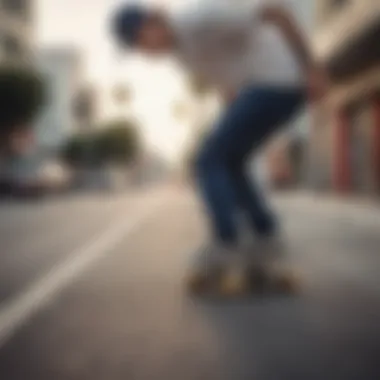
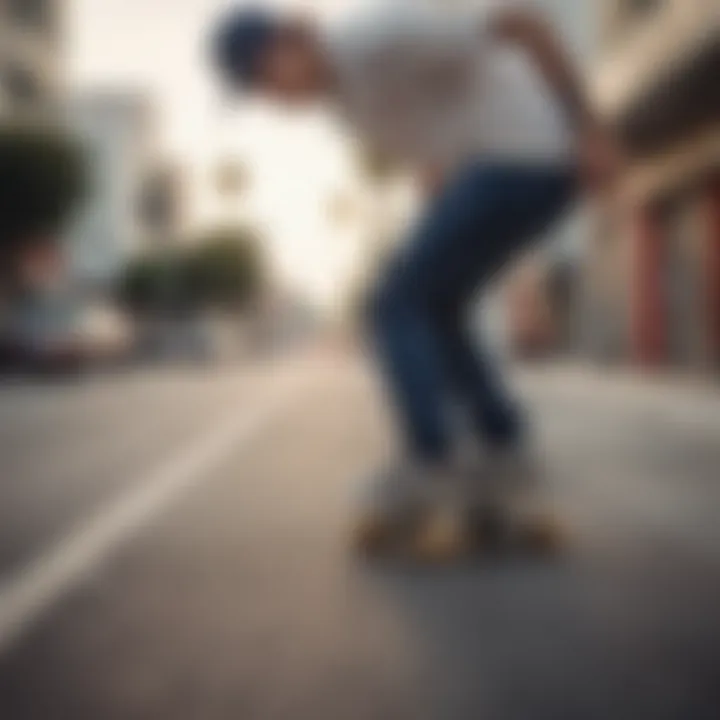
Intro
In the vibrant streets of Los Angeles, skateboarding isn't merely a sport. It's a pulse that reverberates through the culture, shaping styles, techniques, and communities. At the heart of this dynamic scene lies the concept of stance—the way a skater positions themselves on the board, which plays a critical role in their performance and expression.
In chatting with seasoned skaters at iconic locations like Venice Beach, one soon realizes that every kickflip, grind, and ollie is deeply influenced by the kind of stance a skater adopts. This article takes you on a journey diving deep into the essence of ‘stance’ in LA's skate culture, examining how it molds individual skating prowess and fosters connections among enthusiasts. We will traverse through various types of stances, from the classic regular and goofy to the unique adaptations that fantastic local skaters develop.
As we kick things off, we’ll explore the nuances of Techniques and Skills—a critical area for both newcomers and experienced skaters alike. Then, we'll take a stroll down memory lane to grasp the Skateboarding Culture that underpins the community, stars, and evolution of this skateboard scene.
With wheels spinning and ideas flowing, let's lace up our shoes and get rolling into this rich tapestry that celebrates flair and freedom on four wheels!
Prelims to Stance
Understanding stance in the context of skateboarding isn't just about foot placement; it's a fundamental aspect that shapes everything from technique to style. In Los Angeles, where skate culture thrives, the nuances of how skaters position themselves on their boards resonate deeply with both their individual expression and the overall vibe of the skating community. This section will delve into the essence of stance, illustrating its critical role in defining a skater’s identity and performance.
Stance influences how a skater executes tricks, maneuvers through various terrains, and interacts with others in the skateboarding scene. Each unique stance can reflect personality traits or preferences, making it a critical expression tool. For instance, whether one skates with a regular or goofy stance—feet positioning either left or right—can significantly alter performance. Understanding stance also serves practical purposes, informing skaters about their strengths and facilitating targeted skill improvement through tailored training.
Key Considerations in Stance
- Personal Expression: A skater’s stance can mirror their style, mood, and even their cultural background, contributing to the rich tapestry of ‘who they are’ on the board.
- Adaptation and Versatility: As terrain changes, so must the stance. Learning different stances can enhance adaptability and skill versatility—essential traits for any skater aiming to navigate the varied landscapes found in Los Angeles.
- Community Interactions: Stance can affect how skaters relate to one another. The nuances in stance may lead to unique collaborations, as skaters with differing stances might approach the same trick or obstacle entirely differently.
With this in mind, let's explore the actual definition of stance in skateboarding and how it has evolved within the distinctive landscape of Los Angeles.
Defining Stance in Skateboarding
Stance in skateboarding refers primarily to the position of a skater's feet on the board. It dictates the way the skater balances, controls the board during tricks, and maneuvers around obstacles. Predominantly, skaters align themselves in either a regular stance, where the left foot is placed at the front, or a goofy stance, where the right foot leads. Within these basic categories are a wealth of variations that define individual skating styles.
When skaters talk about their stance, they often refer to more than just foot placement; they consider their overall approach to skateboarding, which encompasses their body movements, the tricks they prefer, and even the feel of the board beneath them. The distinction between a regular and goofy skater can be likened to a right-handed versus a left-handed writer—it’s a core aspect of how they engage with their craft.
Historical Overview of Skateboarding in Los Angeles
Los Angeles has long been a cradle for skateboarding, constantly molding and reshaping the sport's identity. The modern skateboarding era found its footing in the oceanside suburbs of this city back in the 1970s and 80s, when surfers sought a way to keep the adrenaline flowing off the waves. Initially, stances were formed out of necessity. Surfers transferred their skills to concrete, where they learned to maneuver through urban landscapes using boards designed for tricks.
As the culture evolved, so did the equipment, the stances, and ultimately the personalities behind the boards. Iconic spots like the Venice Beach skate park and the infamous Dogtown added layers of complexity to styles and tricks, creating a breeding ground for new generations of skaters honing their craft.
By observing how skaters approached various terrains—ranging from transition-heavy parks to street obstacles—one can trace the lineage of stance adaptation through time. Collective public spaces transformed into personal expression venues, and through this paradigm, stances began to reflect not only individual skill sets but also the cultural shifts happening within skateboarding.
Types of Skateboarding Stances
Understanding the various types of skateboarding stances is a cornerstone for grasping the broader culture of skateboarding, particularly in a city like Los Angeles where skate culture thrives. Each stance influences not just the way a skater performs tricks but also shapes their identity within the skate community. Personal preference plays a large role, yet the physical attributes of the skater and the unique terrain they navigate also steer these choices.
Benefits:
These various stances allow skaters to adapt to different environments, ensuring that they can express their individuality while also enhancing their technical skills. Being able to switch between stances can open doors to new tricks and styles, broadening a skater’s repertoire.
Considerations:
Choosing a particular stance often requires skaters to analyze their comfort levels with each position. Beginners might lean towards what's naturally comfortable, often influenced by the dominant leg used in daily activities—left or right. Understanding the psychology and mechanics behind each stance is fundamental for skaters aiming to refine their skills.
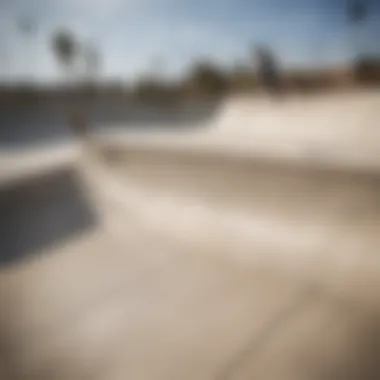
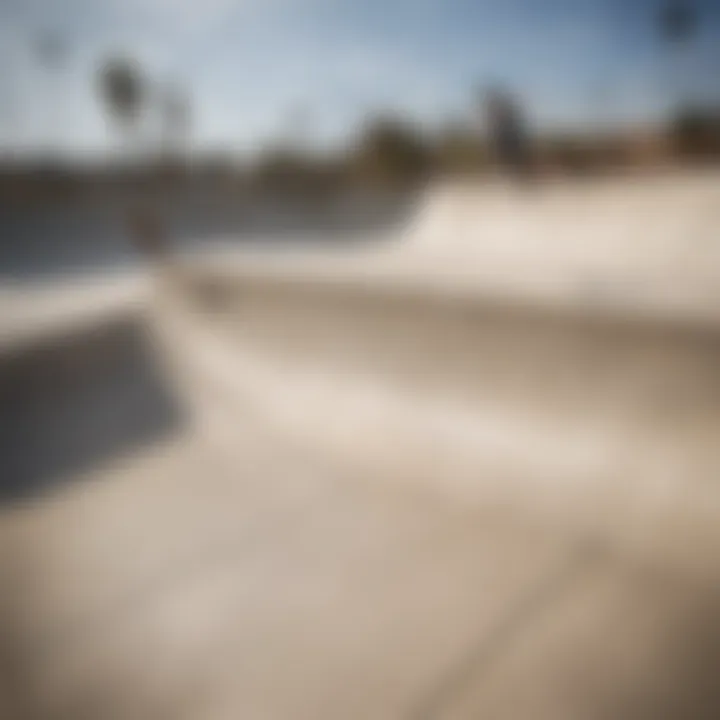
Regular and Goofy Stance Explained
In the world of skateboarding, stances can be broadly categorized into two main types: regular and goofy. A skater adopting a regular stance rides with their left foot forward, while a goofy stance has the right foot in front. The distinctions between the two can sometimes spark heated debates among skaters. It's not just a question of preference; it’s almost a badge of honor within the community.
The stances influence a skater's balance, trick execution, and even their overall style. Regular riders might have a natural flair for specific tricks that can differ dramatically from their goofy counterparts. For example, a regular rider may find it easier to execute a frontside 180, while a goofy skater might rock a backside more fluidly.
Switch Stancing: Skills and Techniques
Switch riding is not just a skill; it’s often viewed as a rite of passage within skate culture. When a skater can perform tricks riding in their non-dominant stance, it opens up a world of possibilities. Switch skating enhances control and balance, essential skills no matter the environment.
To master this technique, one must spend time understanding how movements feel in the opposite position. It might involve trial and error and a whole lot of practice. Skaters often recommend working on simple tricks, like ollies and kickflips, before attempting more complex maneuvers.
"Switch skating transforms how you approach the board, making every trick feel fresh and challenging."
Nollie and Fakie: Understanding These Variations
Aside from the regular and goofy stances, skaters often experiment with nollie and fakie stances.
A nollie occurs when a skater rides with their front foot on the tail and pops the board, resulting in an elevation similar to an ollie but from the front foot. Conversely, riding fakie means a skater rolls with the tail of the board first, while the front foot is positioned on the back. These variations require a deeper understanding of balance and weight distribution, as they encourage skaters to modify their approach to tricks considerably.
As these techniques evolve, skaters learn to integrate them into their artistry, expressing their unique style while evoking a mix of nostalgia and innovation. In Los Angeles—a city renowned for its rich skate history—embracing these diverse stances is essential. Each skater adds to the cultural mosaic that defines this vibrant and ever-evolving community.
The Influence of Terrain on Stance
The landscape of skateboarding is as diverse as the skaters themselves. In Los Angeles, the terrain plays a crucial role in shaping one's stance and skating style. This influence emerges not solely from the type of surface skaters choose but from the broader cultural and practical implications of the environments they navigate. A skater's individual expression is woven into the fabric of the surroundings, where unique characteristics of each space dictate and inform stance adaptation.
Skateboarding in LA is not simply about the tricks; it's also about working with what is available. From smooth concrete parks to the rough surfaces of urban streets, skaters find a rhythm in their stance that reflects their interaction with these terrains. Whether it's the uniformity of skate parks or the unpredictability of street obstacles, every surface demands a tailored approach, offering both challenges and opportunities.
Skate Parks in Los Angeles: A Stance-Friendly Landscape
Los Angeles boasts some of the most iconic skate parks in the world. These parks are designed with a variety of features that cater to different skateboarding styles and stances. Facilities like the Venice Beach Skatepark and the LA Skatelab showcase bowls, ramps, and rails creating an ideal setting for experimentation with stance.
- Flow and Speed: The design of these parks promotes smooth transitions, allowing skaters to establish speed which influences their stance naturally. A skater in a bowl might adopt a wide stance for stability while navigating the curves.
- Feature Variety: From quarter pipes to flat rails, the elements found in these parks provide opportunities to transition between stances, broadening a skater's repertoire. Practicing in such environments allows skaters to switch up their stance easily and find comfort in both regular and goofy setups.
- Community Engagement: These parks are not just places to ride; they are spots where skaters come together, share techniques, and learn from one another. The variation in stances can often spark conversations and collective learning, further establishing a culture of creativity and adaptability.
Street Skating: Adapting Stance to Urban Environments
Venturing beyond the parks, street skating pushes the boundaries of stance adaptability further. The urban landscape presents diverse challenges and features, allowing for limitless possibilities with one's skating stance. A curb, a set of stairs, or a ledge each requires a different stance and skill set.
- Dynamic Changes: Skaters often find themselves needing to adjust their stance on the fly, going from a standard ollie off a ledge to a slide on a rail. This adaptability showcases both technical skill and an intuitive understanding of the terrain's demands.
- Local Terrain Trends: Different neighborhoods in LA may have unique challenges. A skater might adjust their stance when riding the rough textures of downtown compared to the smoother hills of Griffith Park.
- Incorporating Environment: The urban setting encourages skaters to think creatively. Utilizing walls, stair sets, and other structures leads skaters to adopt unconventional stances, further reflecting their innovation and resourcefulness.
"Stance is not merely a choice; it's a conversation between skater and environment, blending style, technique, and location."
Cultural Implications of Stance
Understanding the cultural implications of stance in skateboarding extends beyond the technical aspects of the sport. It's about how skaters express themselves, navigate their identities, and connect with their communities through their choice of stance. Stance often serves as a lens through which individuals interpret their surroundings and their experiences on the board. As skateboarding has evolved, different stances have not only become a personal preference but also a representation of larger cultural trends.
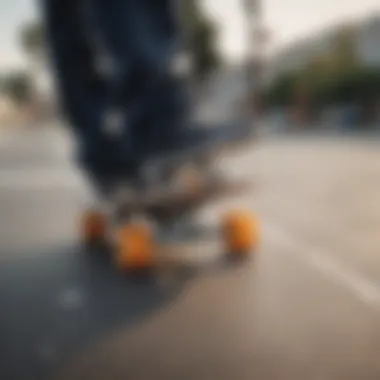
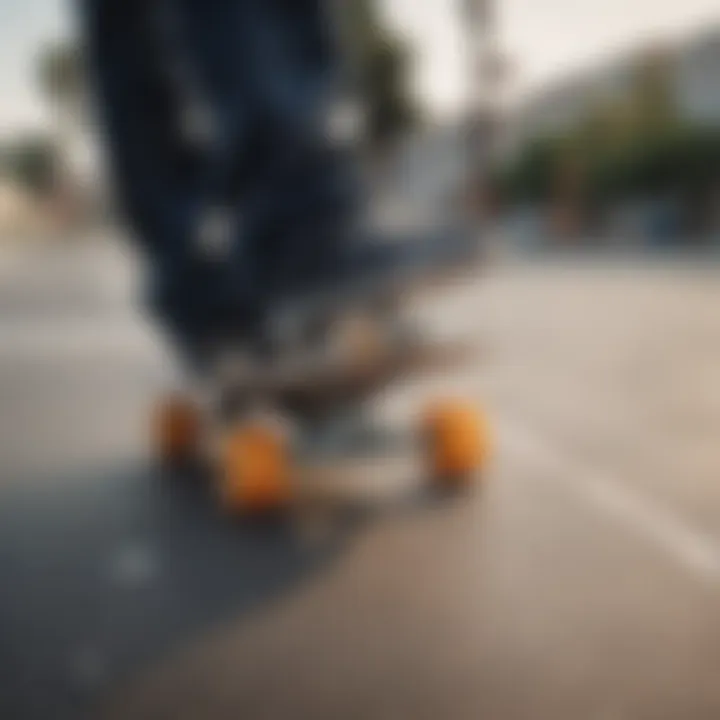
Skateboarding as a Form of Expression
For many skaters, the stance they adopt is more than a mechanical detail; it’s a key part of their identity. From the laid-back, regular stance to the more unconventional goofy setup, each choice reflects a certain attitude or vibe. Like wearing a favorite T-shirt or rocking a signature hat, skaters wear their stances with pride.
The act of skating itself can be likened to a canvas where the skater paints their style. Whether it’s the clean lines of a frontside grind or the chaotic flair of a switch flip, each move is a declaration of individuality. In Los Angeles, where skate culture thrives, there’s a vibrant dialogue between skaters as they constantly innovate and push the boundaries of their stances. This expression is not confined to the skate park; it bleeds into fashion, music, and social interactions, highlighting the interconnectedness of these areas.
"Skateboarding carries stories of resilience, creativity, and raw energy that resonate through every chosen stance."
This connection reveals the emotional core of skating, where stances become personal emblems of rebellion, freedom, and social connection. Skaters adopt particular stances not just for performance but to signal belonging and to express their uniqueness. This cultural layer adds a rich depth to the language of skating that speaks to the complexities of youth identity and community belonging.
The Rise of East-West Stance Differences
Cultural geography plays a significant role in shaping how skaters in various regions interpret stances. The rise of distinct East-West stance differences reveals how local culture, geography, and skate history intersect.
Skaters on the West Coast often embrace the laid-back, surf-influenced styles that reflect the region's relaxed lifestyle. The regular and goofy stances here often exhibit a fluidity and grace that mirrors the ocean waves. In contrast, skaters from the East Coast tend to embody a more raw and aggressive style, which translates into more dynamic stances that often favor complex tricks over style.
Some possible effects of these regional approaches include:
- Innovation: East-coast skaters tend to focus more on street skating, pushing the limits by creating tricks that often require different stances.
- Expression of Identity: Different stances can reflect broader cultural attitudes, where West Coast skaters may favor clean, consistent stances, while East Coast skaters might exhibit more variety in their techniques.
- Community Dynamics: These variances can foster unique local communities, each rallying around specific practices that resonate with their identity, enhancing camaraderie.
Community and Collaboration in Los Angeles
The world of skateboarding is more than just a hobby; it’s a vibrant culture built on community and collaboration. In Los Angeles, this ethos is palpable across the sprawling urban landscape, where skaters come together not just to hone their craft but to foster relationships and share experiences. The importance of community in skating cannot be overstated, as it shapes individual skaters through mentorship, collective learning, and the promotion of diversity in techniques and styles.
By participating in local skateboarding communities, individuals benefit immensely from shared knowledge and skills. This connection often leads to the formation of collectives, where skaters of all levels collaborate to improve their abilities. These groups serve as a support network, encouraging skaters to step outside their comfort zones while providing a safe environment to explore and innovate different stances and tricks. Community also aids in elevating the collective standard of skating, allowing for a richer experience that individual practice alone cannot replicate.
"A strong community doesn't just build better skaters; it builds better characters."
Moreover, community initiatives in Los Angeles often lead to positive outreach programming, encouraging youth involvement and keeping them engaged in constructive activities. This camaraderie, particularly in a city as diverse as L.A., cultivates mutual respect and understanding among skaters from different backgrounds. It’s a melting pot of styles and influences, where various perspectives clash and combine to form a unique cultural identity.
Skateboarding Collectives: Building Skills Together
In Los Angeles, skateboarding collectives embody the spirit of teamwork and collaboration. These groups, often informal yet tightly-knit, consist of individuals who share a passion for skating. Collectives function as platforms for skaters to exchange tricks, techniques, and tips, all while pushing each other to grow. This isn’t merely an act of charity; it’s a mutualistic relationship where everyone ultimately benefits from improved skills.
Such collectives can vary greatly in structure. For example, one collective may focus on street skating, organizing sessions at iconic urban spots like the Venice Skate Park or the Santa Monica Pier. Others might prioritize learning tricks or even hosting friendly competitions to keep the competitive spirit alive.
Some of the key elements that make these collectives impactful include:
- Scheduled Meetups: Regularly planned sessions help maintain motivation among participants.
- Skill Workshops: More experienced skaters often dedicate time to help others master challenging maneuvers.
- Mentorship Opportunities: New skaters frequently look up to seasoned members, leading to a cycle of learning that fuels progress.
Ultimately, these collectives blur the lines of competition, shifting the focus from personal glory to mutual growth. When skaters band together, everyone sharpens their skills and fosters a sense of belonging.
Events Celebrating Diversity in Skate Stances
Celebratory events in L.A. skate culture underline the significant role that diverse stances play in the community. These gatherings often showcase an array of skateboarding styles, from freestyle tricks to street maneuvers. Festivals and contests not only provide entertainment but also allow skaters to exhibit their unique approaches to stance, allowing spectators and fellow skaters alike to appreciate the artistry inherent in each technique.
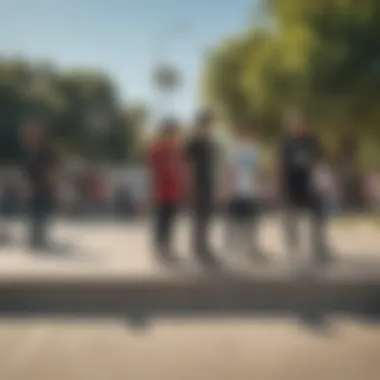

Such events can range from neighborhood block parties that feature local skaters to larger-scale competitions that draw talent from across the nation. They provide an opportunity to bridge gaps between various skating styles, and celebrate different backgrounds, thus creating a more inclusive environment. Some notable aspects of these events include:
- Showcasing Talents: Skaters proudly display their stances and techniques, fostering a culture of respect and admiration.
- Workshops and Clinics: Many events include hands-on skill-building sessions, which encourage skaters to experiment with new stances and further develop their abilities.
- Community Engagement: Local businesses often sponsor these events, creating a sense of economic solidarity within the community.
On a broader scale, these gatherings serve as a gesture of unity within skating. They remind every skater that, regardless of style, they all share a common love for the sport. By celebrating these differences, the Los Angeles skateboard community not only strengthens itself but enhances the overall experience for all involved.
The Future of Stance in Skateboarding
As the wheels of time turn, the domain of skateboarding is continually morphing, with stances at the core of this evolution. Understanding the future of skating stances is pivotal in grasping how techniques, culture, and community engagement will change. Advances in technology, shifts in youth culture, and the growing push for inclusivity might reshape how skaters view and utilize their stance, making this topic both timely and essential.
Emerging Trends in Stance Adaptation
New trends are bubbling in the skateboarding community, pushing skaters to adapt their stance to fit not just personal style but the demands of new terrains and tricks. Here are a few trends worth mentioning:
- Increased Emphasis on Versatility: Skaters are not just sticking to one stance; the trend is now leaning towards fluidity. More skaters are exploring switch positions or mixing styles fluidly during their runs. This adaptability is not merely for show but enhances their technical prowess and opens up various avenues for trick execution.
- Customization Through Technology: Technological innovations, such as smart boards and wearable devices, allow skaters to monitor their movements closely. The goal is to analyze performance statistics based on stance usage, fueling a desire to tailor innovations that align with skating styles and personal preferences mapping.
- Collaboration with Other Sports: Athletes from other extreme sports like snowboarding and surfing are heavily influencing skate culture. Techniques and styles are blending, leading to new stances that reflect this hybrid approach. It’s an exciting fusion that’s growing amongst younger enthusiasts.
As the skateboarding scene becomes more integrated with various other sports, we see a blending of techniques and stances that make skating ever more dynamic.
Potential Challenges and Opportunities
Despite the thrill of innovation and adaptation, the journey into the future of stances doesn’t come without hurdles.
- Diverse Skill Levels: As new trends emerge, it might be challenging for newcomers to keep pace with advanced techniques. Resources and peer support become essential to bridge these gaps. Workshops targeting stance adaptability could emerge as invaluable for teaching all levels.
- Inclusivity and Representation: While trends lean towards broadening the definition of a skater's stance, some voices might feel neglected. Creating spaces for diverse styles and identities should be a priority. Collaboration with community leaders to promote diverse narratives can address this concern and celebrate the uniqueness of skate culture.
- Balancing Tradition with Innovation: There’s always a tension between the classic styles that the ‘old guard’ adheres to and the new vibes coming in from younger generations. Finding a middle ground can generate a rich tapestry of skateboarding culture. Events that highlight traditional stunts against modern takes can foster respect and understanding between different factions of skaters.
Closure: The Enduring Legacy of Stance
The legacy of stance within the skateboarding culture of Los Angeles is not merely a byproduct of tricks or techniques; it is a defining characteristic that shapes the very essence of skate culture. Stance, as explored throughout this discourse, encapsulates a myriad of elements that are critical to the skater’s identity and expression. From the regular and goofy stance to the nuanced variations of nollie and fakie, each approach to skating provides insight into the individuality of the practitioner.
What stands out is how each skater's stance serves as a canvas for personal expression, reflecting their personality and experiences. In a city like Los Angeles, where skateboarding has melded into the urban fabric, this visual representation becomes even more vivid. The places skaters choose to ride—be it a classic skate park or an urban street—often dictate how they express their stance, illustrating an intricate dance between technique and environment.
Additionally, recognizing stance as a cornerstone of community engagement cannot be overstated. Skateboarding collectives and events that celebrate diverse stances encourage collaboration, fostering friendships among skaters. These interactions not only enhance skills but also solidify the community's bond, creating a vibrant ecosystem of learning and sharing.
"Stance in skateboarding extends beyond the individual; it builds bridges within the skate community, making it a collective journey as much as a personal one."
In examining the future, the emerging trends indicate that while stances may evolve, the core of what they represent—identity, culture, and community—will remain steadfast. Understanding this evolution will be crucial for any skater or enthusiast wishing to grasp the full specter of skateboarding's impact within and beyond Los Angeles.
In closing, stance is more than an aspect of skating; it's a lens through which we can appreciate the richness of skate culture, its evolution, and its enduring influence on lifestyle, art, and youth engagement across the globe.
Stance as a Defining Element of Skate Culture
When one thinks of skate culture, the image of a skater in motion often springs to mind. However, what truly defines that image is the skater's stance. It encapsulates their style, skills, and approach to the sport. In Los Angeles, a hub of creativity and innovation, the diversity of stances reflects the diverse backgrounds of its skaters. Regular stanced riders, who lead with their left foot, often emphasize control and stability. In contrast, goofy stanced skaters, leading with the right foot, showcase a unique flair that speaks volumes about their personality.
Furthermore, the cultural implications are significant. Stance can signal allegiance to particular skate factions or influences, creating micro-communities within the larger skate scene. It can even be a representation of a skater’s influences—perhaps the era they grew up in or the prominent figures they idolized. As a result, stance is not just a technical choice but a personal statement reflecting one’s identity in a broader cultural landscape.
Stance in Personal Development of Skaters
Personal development in skateboarding often unfolds in tandem with the evolution of a skater's stance. Initially, skaters might gravitate toward a preferred stance, but mastering variations expands their skill set profoundly. Learning to switch stances is akin to picking up a new language. It requires not just technical execution but also adaptability and resilience.
As skaters progress, the development goes beyond just physical skills. Their stance becomes a medium for self-discovery. Young skaters, often navigating the complexities of adolescence, use skateboarding as an outlet. The act of skating, compounded by the discovery of their preferred stance, offers a sense of belonging and confidence.
Moreover, by adapting their stances to various terrains, skaters cultivate problem-solving skills. From hitting unique spots around Los Angeles to participating in competitions, their ability to adjust becomes an essential life lesson—one that transcends skateboarding into other areas of their lives. The journey they embark upon teaches them not only how to skate but also how to face challenges head-on, making them more than just skaters; they emerge as resilient individuals in a constantly changing world.







